
Hayahiko Ozono
(Okayama University Library)
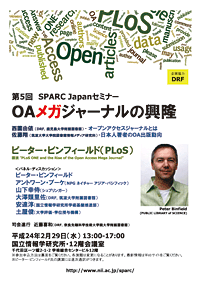
Handouts
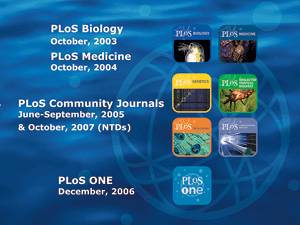
OA journals published by the PLoS ONE
Source: Peter Binfield (2012), presentation materials for the 5th SPARC Japan Seminar 2011, http://www.nii.ac.jp/sparc/event/2011/pdf/5/3_binfield.pdf
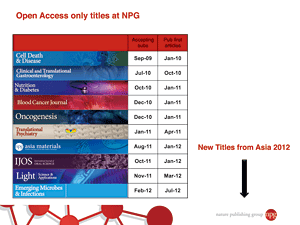
OA journals published by the Nature Publishing Group
Source: Antoine E. Bocquet (2012), presentation materials for the 5th SPARC Japan Seminar 2011,
http://www.nii.ac.jp/sparc/event/2011/pdf/5/4_bocquet.pdf

OA journals published by the Springer
Source: Koji Yamashita (2012), presentation materials for the 5th SPARC Japan Seminar 2011,
http://www.nii.ac.jp/sparc/event/2011/pdf/5/5_yamashita.pdf
This was the first time I had heard the term “Open Access MegaJournals” (hereinafter “OA MegaJournals”). One business model for open access is a system in which authors pay article-processing charges (APC) so as to enable publishers to offer e-journals free of charge. Simply put, OA MegaJournals refer to OA e-journals that are extremely large in size. According to what I have learned, it is possible to publish a large number of quality-vetted articles by improving the efficiency of the peer review process, for instance, by adopting cascading peer review. PLoS ONE is the forerunner in this approach, publishing as many as 14,000 articles in fiscal 2011. We also heard that the era of full-fledged open access is approaching in the areas of science, technology, and medicine (STM), with more and more commercial publishers adopting the same business model. This is a wonderful development. For details of the seminar, please refer to the SPARC Japan website.1
Now, let’s imagine the wonderful future where OA MegaJournals are widely available. Almost all papers published would be made available free of charge. OA journals would attract many researchers as readers. A system that catches eyes of many researchers would naturally attract more articles, which would be published in OA journals, thereby creating a positive growth cycle of open access. As such, we are seemingly heading for a bright future.
Provided that OA MegaJournals are to grow through this kind of cycle, those that have initiated the move earlier would enjoy greater name value and have greater chances to attract more submissions. It would be almost impossible for those journals lagging behind to compete with those going before them, unless they have significant name value from the very beginning. This kind of system would cause the concentration of articles in specific journals, resulting in more time required for processing for publication. Most participants in the panel discussion at the seminar were in the view that APC rates would increase going forward. What if an unbridgeable gap has been formed between the leading and lagging groups of journals by the time APC rates begin to rise rapidly? In a market dominated by a small number of OA MegaJournals, can we expect APC rates to settle at a reasonable level? Under the current subscription model, libraries are working to prevent journal subscription fees from rising too high by forming consortiums. However, if this model is gone, libraries will not be able to make such interventions. What can libraries do to make the era of open access better? Asking this question reminded me of the five laws of library science2 proposed by S. R. Ranganathan:
1. Books are for use.
2. Every reader his [or her] book.
3. Every book its reader.
4. Save the time of the reader.
5. The library is a growing organism.
Even if we move into the era of OA MegaJournals and a large number of research papers become accessible to readers free of charge, appropriate papers do not necessarily find appropriate readers. Today, a time in which the volume of information is increasing explosively, we are having an information access problem that is quite different from that in the time of Ranganathan. However, so far as academic information is concerned, the filtering function of academic journals is working, for better or for worse, as a guide for setting the priority order. Here I would like to focus on the third and fourth laws. In the time of Ranganathan, the primary means of achieving these laws are to inform user of the availability of resources — through library catalogs, classified arrangement of books, reference services, etc. — and collect resources in consideration of requests from users. In contrast, in today’s highly digitized world, it is important to create an environment that enables a comprehensive search of all academic information available and offer information search systems optimized for specific users in accordance with their needs. In order to save the time for users, it is necessary to develop the skills and capabilities of library staff and improve their work process to better reflect the priority of services. By implementing these measures, we will be able to find appropriate readers for appropriate papers as quickly as possible. This is nothing new. After all, continuing to improve library services in the same way as we have been doing will weakens the journal filtering effect in terms of utilization, resulting in the greater use of papers. I believe that this, in turn, will ensure appropriate competition among OA MegaJournals as well as between OA MegaJournals and other journals, leading to the realization of appropriate APC rates. Ranganathan’s fifth law says, “The library is a growing organism.” Taking these words into my heart, I would say, “Come on, OA MegaJournals. We are ready.”
References
| 1. |
The 5th SPARC Japan Seminar 2011. “Burgeoning Open Access MegaJournals”. National Institute of Informatics.
http://www.nii.ac.jp/sparc/event/2011/20120229.html (accessed 2012-06-05). |
| 2. |
S. R. Ranganathan. “The Five Laws of Library Science” in Japanese translation by Shinichi Watanabe et al. Japan Library Association, 1981, 425p. |

Masanori Arita
(Department of Biophysics and Biochemistry,
Graduate School of Science, the University of Tokyo)
On attending the 5th SPARC Japan Seminar “Burgeoning Open Access MegaJournals” what struck me was the sheer distance that separates publishers, libraries, and researchers. This kind of theme should be discussed by all the three players head to head. However, very few researchers were found among audience, though this is no more than my guess that researchers would be just as shabbily dressed as I am. Maybe many researchers at the seminar happened to be well dressed. When we talk about academic publishing, we are haunted by the term “business model.” For any commercial publisher, however, business — making profits — must come first. Even in the case of not-for-profit publishers, which can be defined as corporations that do not distribute profits to shareholders, there is no advancement without being profitable. At the seminar, Dr. Binfield from the Public Library of Science (PLoS) talked about the remarkable commercial success of the PLoS ONE, predicting that comprehensive journals such as the PLoS ONE will dominate the world of scholarly publishing. Likewise, Dr. Bocquet from Nature Japan emphasized the concept of impact factor, to which the Nature series attach the greatest importance, and noted that the authority and vigor of the top journal will remain intact. Probably they are both right. Indeed, these are brilliant predictions made by brilliant journal publishers based on their brilliant business models. However, being a contrary person, I dare to raise a question. Is such a business model supported by a sound market? That is, are their revenues derived from subscription or submission fees that have been critically assessed by readers? Unfortunately, the reality seems otherwise. Many researchers do not know the actual state of academic publishing. Deluding themselves to the idea that honorable is to be engrossed in research and unfamiliar with worldly affairs, researchers often make it their goal to write research papers and have them published, particularly, in those journals with high impact factors. For such researchers, differences among journals or publishers are no more than differences in numeric scores (impact factors). As commented by Dr. Adachi from the National Institute of Informatics, who spoke as a representative from the field of computer science, researchers in the areas of medical and biological science have a strange habit of submitting their papers in sequence in the order of the impact factor ranking, starting from the highest. This is why such a system as cascading peer review has been developed. To put it nastily, researchers in the areas of medical and biological science are submitting their papers to journals with higher impact factors first, betting on their luck. It is hard to believe that they are actually giving consideration to the policies of their target journals or the legitimacy of publication fees.
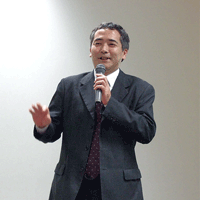
Opening greeting by Shigeki Sugita (DRF, Otaru University of Commerce Library)
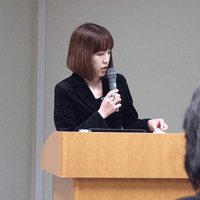
Lecture by Yui Nishizono (DRF, Kagoshima University Library)
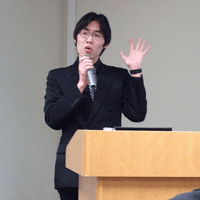
Lecture by Sho Sato (Graduate School of Library, Information and Media Studies (second stage of doctoral program), University of Tsukuba)
For instance, the Nature, albeit allowing self-archiving, is basically a commercial journal and all published papers are copyrighted by the Nature Publishing Group (NPG). PLoS was established out of the concern that publicly-funded research need not be published by profit-seeking companies. Therefore, if there are researchers who would submit their articles to PLoS only after failing to have them published in the Nature, they are failing to see the spirit of PLoS. This is, of course, an extreme argument. Being a researcher myself, I know that decision-making in practice is far more difficult than that. I should also add that the Nature deserves appreciation in many respects. However, let me cite another example involving the NPG. It charges 640,000 yen per publication to be open access (OA) in the Nature Communications, a new comprehensive scholarly journal. Is this amount reasonable in the light of common sense? I do not think so. And yet, as pointed out at the seminar, Japan ranks the second in the world in the number of submissions and the third in the number of articles accepted (the United States ranks the first in both). Japanese researchers are very good customers. Indeed, many researchers seem to be ready to pay that much for having their articles published in the Nature series; more than half biological science researchers opt for OA, as introduced at the seminar. But it may be because publication fees are paid out of research funds. For instance, if researchers are to pay 64,000 yen per publication, or 10 percent of the OA charge, themselves, how many of them will opt for OA? Japanese researchers should ask themselves whether they have been behaving correctly as customers of this enormous business called academic publishing.
University libraries are crucial in discussing the relationship between researchers and scholarly publishers. To be honest, until I attended this seminar, I had not been aware of the close relationship between the Japan Association of National University Libraries (JANUL) and SPARC. However, coming to think about it, this is nothing surprising. Researchers have been able to remain indifferent to scholarly publishing only because university libraries represent their interest and negotiate on behalf of them. In other words, we have been spoilt too much for too long. At the seminar, Ms. Nishizono from Kagoshima University Library provoked, in a modest manner, a discussion over the issue of publishing costs based on detailed survey results. According to her presentation, the cost of production is about 1,100 US dollars per article even for the PLoS Biology, which deserves to be called a first class journal. Even considering the costs of peer review, many open access journals — those which accept more than half submissions and do not bother to edit them — seem to be making easy money. This is why commercial publishers have joined the open access bandwagon. By the way, Dr. Binfield said that the PLoS ONE has been so profitable that it plans to reduce the submission fees. I was surprised to hear that and it made me admire the PLoS. But putting that aside, researchers must understand the reality faced by libraries and cooperate with them, which I believe will take the first step toward dealing with commercial publishers on an equal footing. The seminar, which shed light on problems with researchers from various angles, turned out to be a precious learning opportunity for me. For this reason, I would like to see many researchers participate in future events and see the reality. I wrote a related article and had it published in the May 2012 edition of the Kagaku, a monthly journal from Iwanami Shoten. I would be grateful if readers will take a look at it.
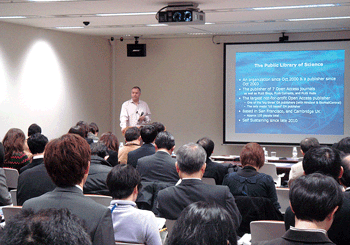 |
 |
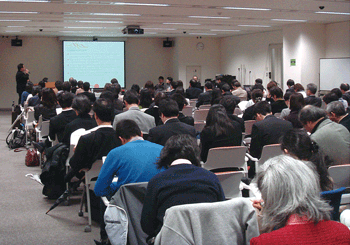 |
| Lecture by Peter Binfield (Public Library of Science) | | Lecture presentation |
 | | |
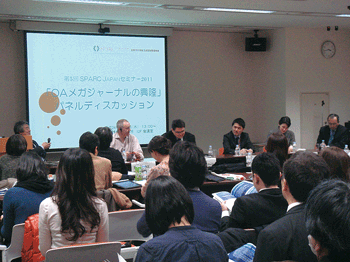 |
|
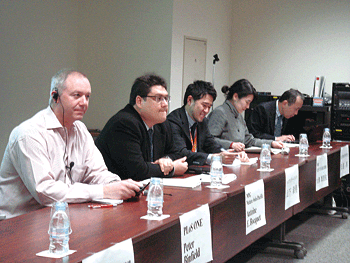 |
| Panel discussion | | Panelists (from left): Peter Binfield (Public Library of Science), Antoine E. Bocquet (NPG Nature Asia-Pacific), Koji Yamashita (Springer Japan KK), Rulisa Osawa (DRF, University of Tsukuba Library), and Jun Adachi (National Institute of Informatics) |
|

